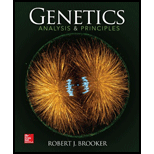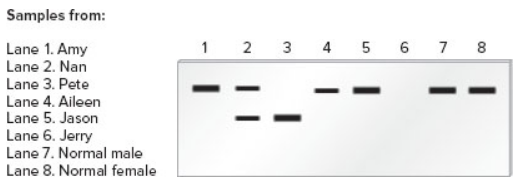
Concept explainers
Chapter 21 describes a method known as Western blotting that can be used to detect a polypeptide that is translated from a particular mRNA. In this method, a particular polypeptide or protein is detected by an antibody that specifically recognizes a segment of its amino acid sequence. After the antibody binds to the polypeptide within a gel, a secondary antibody (which is labeled) is used to visualize the polypeptide as a dark band. For example, an antibody that recognizes α-galactosidase A could be used to specifically detect the amount of α-galactosidase A protein on a gel. The enzyme α-galactosidase A is defective in individuals with Fabry disease, which shows an X-linked recessive pattern of inheritance. Amy, Nan, and Pete are siblings, and Pete has Fabry disease. Aileen, Jason, and Jerry are brothers and sister, and Jerry has Fabry disease. Amy, Nan, and Pete are not related to Aileen, Jason, and Jerry. Amy, Nan, and Aileen are concerned that they could be carriers of a defective α-galactosidase A gene. A sample of cells was obtained from each of these six individuals and subjected to Western blotting, using an antibody against α-galactosidase A. Samples were also obtained from two unrelated normal individuals (lanes 7 and 8). The results are shown here.
(Note: Due to X-chromosome inactivation in females, the amount of expression of genes on the single X chromosome in males is equal to the amount of expression from genes on both X chromosomes in females.)

A. Explain the type of mutation (e.g., missense, nonsense, promoter, etc.) that caused Fabry disease in Pete and Jerry.
B. What would you tell Amy, Nan, and Aileen regarding the likelihood that they are carriers of the mutant allele and the probability of having affected offspring?
Want to see the full answer?
Check out a sample textbook solution
Chapter 24 Solutions
Genetics: Analysis and Principles
- Find the dental formula and enter it in the following format: I3/3 C1/1 P4/4 M2/3 = 42 (this is not the correct number, just the correct format) Please be aware: the upper jaw is intact (all teeth are present). The bottom jaw/mandible is not intact. The front teeth should include 6 total rectangular teeth (3 on each side) and 2 total large triangular teeth (1 on each side).arrow_forward12. Calculate the area of a circle which has a radius of 1200 μm. Give your answer in mm² in scientific notation with the correct number of significant figures.arrow_forwardDescribe the image quality of the B.megaterium at 1000X before adding oil? What does adding oil do to the quality of the image?arrow_forward
- Which of the follwowing cells from this lab do you expect to have a nucleus and why or why not? Ceratium, Bacillus megaterium and Cheek epithelial cells?arrow_forward14. If you determine there to be debris on your ocular lens, explain what is the best way to clean it off without damaging the lens?arrow_forward11. Write a simple formula for converting mm to μm when the number of mm's is known. Use the variable X to represent the number of mm's in your formula.arrow_forward
- 13. When a smear containing cells is dried, the cells shrink due to the loss of water. What technique could you use to visualize and measure living cells without heat-fixing them? Hint: you did this technique in part I.arrow_forward10. Write a simple formula for converting μm to mm when the number of μm's are known. Use the variable X to represent the number of um's in your formula.arrow_forward8. How many μm² is in one cm²; express the result in scientific notation. Show your calculations. 1 cm = 10 mm; 1 mm = 1000 μmarrow_forward
- Find the dental formula and enter it in the following format: I3/3 C1/1 P4/4 M2/3 = 42 (this is not the correct number, just the correct format) Please be aware: the upper jaw is intact (all teeth are present). The bottom jaw/mandible is not intact. The front teeth should include 6 total rectangular teeth (3 on each side) and 2 total large triangular teeth (1 on each side).arrow_forwardAnswer iarrow_forwardAnswerarrow_forward
 Human Heredity: Principles and Issues (MindTap Co...BiologyISBN:9781305251052Author:Michael CummingsPublisher:Cengage Learning
Human Heredity: Principles and Issues (MindTap Co...BiologyISBN:9781305251052Author:Michael CummingsPublisher:Cengage Learning Biology (MindTap Course List)BiologyISBN:9781337392938Author:Eldra Solomon, Charles Martin, Diana W. Martin, Linda R. BergPublisher:Cengage Learning
Biology (MindTap Course List)BiologyISBN:9781337392938Author:Eldra Solomon, Charles Martin, Diana W. Martin, Linda R. BergPublisher:Cengage Learning
 Biology Today and Tomorrow without Physiology (Mi...BiologyISBN:9781305117396Author:Cecie Starr, Christine Evers, Lisa StarrPublisher:Cengage Learning
Biology Today and Tomorrow without Physiology (Mi...BiologyISBN:9781305117396Author:Cecie Starr, Christine Evers, Lisa StarrPublisher:Cengage Learning Human Biology (MindTap Course List)BiologyISBN:9781305112100Author:Cecie Starr, Beverly McMillanPublisher:Cengage Learning
Human Biology (MindTap Course List)BiologyISBN:9781305112100Author:Cecie Starr, Beverly McMillanPublisher:Cengage Learning





